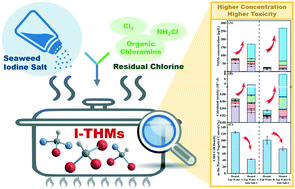Comparison of iodinated disinfection by-product formation from the reaction of chlorine, monochloramine, and organic chloramine with seaweed salt during a simulated household cooking process†
Abstract
Our recent study validated that household cooking with seaweed salt and chloraminated water can significantly promote iodinated disinfection by-product (I-DBP) formation. Given that several disinfectants might coexist or partially exist in tap water, it is necessary to investigate the effect of disinfectant species (chlorine, monochloramine, and organic chloramine) on I-DBP formation from seaweed salt. The results showed that iodinated trihalomethanes (I-THMs) formed with disinfectant species followed the order: monochloramine > chlorine > in situ organic chloramine ≥ preformed organic chloramine. As reaction temperature and time raised, I-THM formation increased and then decreased. The slight decrease of I-THMs at a high temperature (95 °C) during chlorination and chloramination resulted from the hydrolysis and volatilization of THMs, whereas the instability of organic chloramines at high temperatures (80 °C and 95 °C) resulted in the significant reduction of I-THMs. Owing to the addition of seaweed salt, the I-THM concentrations in two realistic tap waters (chlorination and chloramination) after simulated household cooking significantly increased by ∼2 orders of magnitude to 119.6 μg L−1 and 245.3 μg L−1, concurring with the growth of bioassay-based and the calculated additive cytotoxicity to Chinese hamster ovary cells. This study demonstrated that the I-DBP concentration of tap water for epidemiological exposure assessments might underestimate the potential health risk of I-DBPs formed from household cooking with seaweed salt.



 Please wait while we load your content...
Please wait while we load your content...